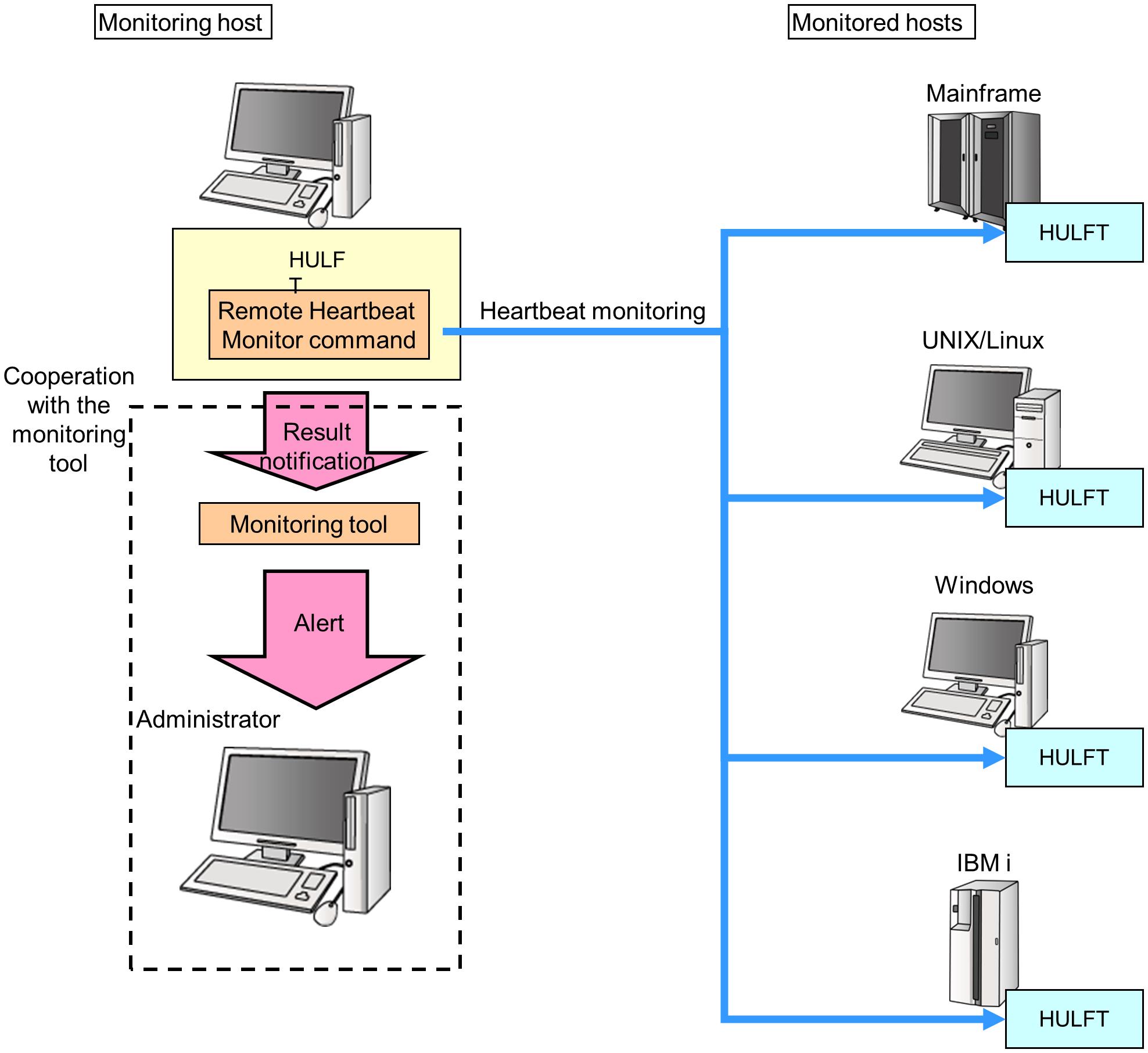Remote Heartbeat Monitor function
The Remote Heartbeat Monitor function monitors the heartbeat status of HULFT resident processes on the local host and other hosts connected to the local host via the network.
The Remote Heartbeat Monitor function executes the Remote Heartbeat Monitor command (utlalivecheck) from the monitoring host to confirm the status of processes on the host being monitored (monitored host).
Using the Remote Heartbeat Monitor function with monitoring tools allows for an alert to be sent to a HULFT operation administrator if a problem is reported in the monitoring results.
If you specify "U" (UNIX domain socket) for Send Daemon Communication Method (sddrequestmethod), you cannot use the Remote Heartbeat Monitoring function to monitor the Send daemon. If you want to monitor the Send daemon, specify "S" (Normal socket) for Send Daemon Communication Method (sddrequestmethod).

Figure 2.48 Example Operation of Remote Heartbeat Monitor Function
Targets that can be monitored will vary depending on the host type and the version of HULFT installed on the monitored host. What is monitored is shown in the following tables by host type:
|
|
HULFT-SAN Ver.5 |
HULFT Ver.6 |
HULFT7 |
HULFT8 |
|---|---|---|---|---|
|
Send program |
- |
- |
- |
- |
|
Receive program |
- |
✓ |
✓ |
✓ |
|
Observe program |
- |
✓ |
✓ |
✓ |
|
✓ |
: |
Monitored |
|
- |
: |
Not monitored |
|
* |
: |
HULFT for Mainframe |
|
|
HULFT-SAN Ver.5 |
HULFT Ver.6 |
HULFT Ver.7 |
HULFT8 |
|
|---|---|---|---|---|---|
|
Lower than Ver.7.2 |
Ver.7.2 or higher |
||||
|
Send daemon |
- |
- |
- |
✓ |
✓ |
|
Receive daemon |
- |
✓ |
✓ |
✓ |
✓ |
|
Observe daemon |
- |
✓ |
✓ |
✓ |
✓ |
|
✓ |
: |
Monitored |
|
- |
: |
Not monitored |
|
* |
: |
HULFT for UNIX/Linux |
|
|
HULFT-SAN Ver.5 |
HULFT Ver.6 |
HULFT Ver.7 |
HULFT8 |
|
|---|---|---|---|---|---|
|
Lower than Ver.7.2 |
Ver.7.2 or higher |
||||
|
Send process |
- |
✓ |
✓ |
✓ |
✓ |
|
Receive process |
- |
✓ |
✓ |
✓ |
✓ |
|
Observe process |
- |
✓ |
✓ |
✓ |
✓ |
|
Service |
- |
- |
- |
✓ |
✓ |
|
Scheduler process |
- |
- |
- |
✓ |
✓ |
|
✓ |
: |
Monitored |
|
- |
: |
Not monitored |
|
* |
: |
HULFT for Windows |
|
|
HULFT Ver.6 |
HULFT Ver.7 |
HULFT8 |
|---|---|---|---|
|
Send job |
✓ |
✓ |
✓ |
|
Receive job |
✓ |
✓ |
✓ |
|
Observe job |
✓ |
✓ |
✓ |
|
✓ |
: |
Monitored |
|
- |
: |
Not monitored |
|
* |
: |
HULFT for IBMi |
|
|
HULFT7 |
|---|---|
|
Send daemon |
- |
|
Receive daemon |
✓ |
|
Observe daemon |
✓ |
|
✓ |
: |
Monitored |
|
- |
: |
Not monitored |
|
* |
: |
HULFT for NSK |
|
|
HULFT Ver.6 |
|---|---|
|
Send program |
- |
|
Receive program |
✓ |
|
Observe program |
✓ |
|
✓ |
: |
Monitored |
|
- |
: |
Not monitored |
|
* |
: |
HULFT for Mainframe Type VOS-S Ver.6 and HULFT for Mainframe Type VOS Ver.6 |
|
|
Ver.5 |
|---|---|
|
Send program |
- |
|
Receive program |
- |
|
Observe program |
- |
|
✓ |
: |
Monitored |
|
- |
: |
Not monitored |
|
* |
: |
HULFT for Mainframe Type ACOS Ver.5 |
|
|
Ver.2.1 |
|---|---|
|
Send program |
- |
|
Receive program |
- |
|
Observe program |
- |
|
✓ |
: |
Monitored |
|
- |
: |
Not monitored |
|
* |
: |
HULFT for K |
The communication ports for the processes must be opened in order to monitor the processes.
The Remote Heartbeat Monitor function operates by having each process open a communication port and send or receive the protocol. Therefore, in order to monitor each process, you must open the ports by configuring the firewall settings.